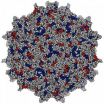(Press-News.org) PHILADELPHIA -- Penn Medicine researchers have developed a better way to assess and diagnose psychosis in young children. By "growth charting" cognitive development alongside the presentation of psychotic symptoms, they have demonstrated that the most significant lags in cognitive development correlate with the most severe cases of psychosis. Their findings are published online this month in JAMA Psychiatry.
"We know that disorders such as schizophrenia come with a functional decline as well as a concurrent cognitive decline," says Ruben Gur, PhD, director of the Brain Behavior Laboratory and professor of Neuropsychology at the Perelman School of Medicine of the University of Pennsylvania. "Most physicians have a clinical basis from which to assess psychosis, but less idea as to how to best assess and measure a decline in cognitive function. To make this easier and to aid in early diagnosis and treatment, we created 'growth charts' of cognitive development to integrate brain behavior into the diagnostic process."
Psychosis is a severe mental illness, characterized by hallucinations, delusions, social withdrawal and a loss of contact with reality. Genetics and environment, including emotional or physical trauma, can both play a role in its development.
The Penn researchers assessed the brain behavior of a cohort of about 10,000 patients between the ages of eight and 21 at Children's Hospital of Philadelphia from November 2009 to November 2011, including 2,321 who reported psychotic symptoms. Of those, 1,423 reported significant psychotic symptoms, 898 had limited psychotic symptoms, and 1,963 were typically developing children with no psychotic, mental or any medical disorders.
Researchers administered a structured psychiatric evaluation, looking for symptoms of psychosis, anxiety, mood, attention-deficit, disruptive behavior and eating disorders; for the younger children, independent interviews with their caregivers were also conducted. The team also administered 12 computerized neurocognitive tests to evaluate each child's brain development across five domains: executive function, testing abstraction and mental flexibility, attention and working memory; episodic memory, testing knowledge of words, faces and shapes; complex cognition, evaluating verbal and nonverbal reasoning and spatial processing; social cognition, looking at emotion identification, intensity differentiation and age estimation; and sensorimotor speed, to understand the workings of their motor and sensorimotor skills.
The results were analyzed to predict chronological age for each child.
They showed that those with the most extreme psychotic symptoms had a lower chronological than predicted age, compared with the typically-developing group and the group with other psychiatric symptoms. They also had a greater developmental lag than the psychosis-limited group, with the lags most pronounced for complex cognition and social cognition and smallest for sensorimotor speed.
"Broken down further, we found that boys on the psychosis spectrum showed an early decline in memory, complex and social understanding, compared with typically developing children, while girls showed minimal lag in memory across all ages groups, with a lag in complex cognition appearing later in development," explains Gur. This seems to follow the differences in how disorders such as schizophrenia manifest themselves across the sexes.
Further, the team used the results to conclude that delays associated with psychotic symptoms appear to be between six and 18 months, and students are almost a year behind already by age eight. After age 16, the lag widens across all domains, which echoes literature showing cognitive deficits in school-age children eventually diagnosed as having psychosis.
"We now have a tool for parents, educators and clinicians to assess children's clinical symptoms, combined with brain function, to aid in early detection and targeted interventions to make a difference for affected kids before their disease is allowed to progress," says Gur.
Additional Penn Medicine researchers include Monica E. Calkins, PhD; Theodore D. Satterthwaite, MD, MA; Kosh Ruparel, MSE; Warren Bilker, PhD; Tyler M. Moore, PhD; Racquel Gur, MD, PhD, from the department of Psychiatry; and Hakon Hakonarson, MD, PhD, with Children's Hospital of Philadelphia.
INFORMATION:
The study was supported by the National Institutes of Health; RC2 grants MHO89983 and MHO89924 and KO8MH79364.
Penn Medicine is one of the world's leading academic medical centers, dedicated to the related missions of medical education, biomedical research, and excellence in patient care. Penn Medicine consists of the Raymond and Ruth Perelman School of Medicine at the University of Pennsylvania (founded in 1765 as the nation's first medical school) and the University of Pennsylvania Health System, which together form a $4.3 billion enterprise.
The Perelman School of Medicine has been ranked among the top five medical schools in the United States for the past 16 years, according to U.S. News & World Report's survey of research-oriented medical schools. The School is consistently among the nation's top recipients of funding from the National Institutes of Health, with $398 million awarded in the 2012 fiscal year.
The University of Pennsylvania Health System's patient care facilities include: The Hospital of the University of Pennsylvania -- recognized as one of the nation's top "Honor Roll" hospitals by U.S. News & World Report; Penn Presbyterian Medical Center; Chester County Hospital; Penn Wissahickon Hospice; and Pennsylvania Hospital -- the nation's first hospital, founded in 1751. Additional affiliated inpatient care facilities and services throughout the Philadelphia region include Chestnut Hill Hospital and Good Shepherd Penn Partners, a partnership between Good Shepherd Rehabilitation Network and Penn Medicine.
Penn Medicine is committed to improving lives and health through a variety of community-based programs and activities. In fiscal year 2012, Penn Medicine provided $827 million to benefit our community.
Penn Medicine: Cognitive development 'growth charts' may help diagnose and treat psychosis-risk kids
2014-02-12
ELSE PRESS RELEASES FROM THIS DATE:
UNC study reveals potential route to bladder cancer diagnostics, treatments
2014-02-12
CHAPEL HILL, NC – Researchers at the UNC School of Medicine conducted a comprehensive genetic analysis of invasive bladder cancer tumors to discover that the disease shares genetic similarities with two forms of breast cancer. The finding is significant because a greater understanding of the genetic basis of cancers, such as breast cancers, has in the recent past led to the development of new therapies and diagnostic aids.
Bladder cancer, which is the fourth most common malignancy in men and ninth in women in the United States, claimed more than 15,000 lives last year.
The ...
Change in guidelines for Type 2 diabetes screening may lead to under-diagnosis in children
2014-02-12
Ann Arbor, Mich. – New American Diabetes Association (ADA) screening guidelines may lead to the missed diagnoses of type 2 diabetes in children, according to a new study by University of Michigan.
The research, published in the Journal of Adolescent Health, finds that both pediatric and family medicine providers who care for children are using screening tests for type 2 diabetes that may result in missed diagnoses for children, says lead author Joyce Lee, M.D., M.P.H., associate professor in U-M's Departments of Pediatrics and Communicable Diseases and Environmental ...
New imaging technique can diagnose common heart condition
2014-02-12
CHICAGO --- A new imaging technique for measuring blood flow in the heart and vessels can diagnose a common congenital heart abnormality, bicuspid aortic valve, and may lead to better prediction of complications.
A Northwestern Medicine team reported the finding in the journal Circulation. In the study, the authors demonstrated for the first time a previously unknown relationship between heart valve abnormalities, blood flow changes in the heart and aortic disease. They showed that blood flow changes were driven by specific types of abnormal aortic valves, and they were ...
Four new galaxy clusters take researchers further back in time
2014-02-12
Four unknown galaxy clusters each potentially containing thousands of individual galaxies have been discovered some 10 billion light years from Earth.
An international team of astronomers, led by Imperial College London, used a new way of combining data from the two European Space Agency satellites, Planck and Herschel, to identify more distant galaxy clusters than has previously been possible. The researchers believe up to 2000 further clusters could be identified using this technique, helping to build a more detailed timeline of how clusters are formed.
Galaxy clusters ...
Thatcher's policies condemned for causing 'unjust premature death'
2014-02-12
Dr Alex Scott-Samuel and colleagues from the Universities of Durham, West of Scotland, Glasgow and Edinburgh, sourced data from over 70 existing research papers, which concludes that as a result of unnecessary unemployment, welfare cuts and damaging housing policies, the former prime minister's legacy "includes the unnecessary and unjust premature death of many British citizens, together with a substantial and continuing burden of suffering and loss of well-being."
Speaking about the figures, Dr Scott-Samuel said: "Towards the end of the 1980s we were seeing around 500 ...
Better RNA interference, inspired by nature
2014-02-11
CAMBRIDGE, MA -- Inspired by tiny particles that carry cholesterol through the body, MIT chemical engineers have designed nanoparticles that can deliver snippets of genetic material that turn off disease-causing genes.
This approach, known as RNA interference (RNAi), holds great promise for treating cancer and other diseases. However, delivering enough RNA to treat the diseased tissue, while avoiding side effects in the rest of the body, has proven difficult.
The new MIT particles, which encase short strands of RNA within a sphere of fatty molecules and proteins, silence ...
University of Tennessee study finds crocodiles climb trees
2014-02-11
When most people envision crocodiles, they think of them waddling on the ground or wading in water—not climbing trees. However, a University of Tennessee, Knoxville, study has found that the reptiles can climb trees as far as the crowns.
Vladimir Dinets, a research assistant professor in the Department of Psychology, is the first to thoroughly study the tree-climbing and -basking behavior. The research is published in the journal Herpetology Notes and can be found at http://bit.ly/Myi8yr.
Dinets and his colleagues observed crocodile species on three continents—Australia, ...
Caltech-developed method for delivering HIV-fighting antibodies proven even more promising
2014-02-11
In 2011, biologists at the California Institute of Technology (Caltech) demonstrated a highly effective method for delivering HIV-fighting antibodies to mice—a treatment that protected the mice from infection by a laboratory strain of HIV delivered intravenously. Now the researchers, led by Nobel Laureate David Baltimore, have shown that the same procedure is just as effective against a strain of HIV found in the real world, even when transmitted across mucosal surfaces.
The findings, which appear in the February 9 advance online publication of the journal Nature Medicine, ...
The content of our cooperation, not the color of our skin
2014-02-11
It's widely acknowledged that a common threat unites people. Individuals who were previously separated by social class, race or ethnicity come together, forming new cooperative alliances to defeat a common enemy. But does it take an external threat — an attack like Pearl Harbor or 9/11 — to make these social divisions melt away?
A study by behavioral scientists at UC Santa Barbara demonstrates that peaceful cooperation has the same effect as intergroup conflict in erasing social boundaries connected to race. Their findings appear today in the journal PLOS ONE.
"Evolution ...
Fish living near the equator will not thrive in the warmer oceans of the future
2014-02-11
According to an international team of researchers, the rapid pace of climate change is threatening the future presence of fish near the equator.
"Our studies found that one species of fish could not even survive in water just three degrees Celsius warmer than what it lives in now," says the lead author of the study, Dr Jodie Rummer from the ARC Centre of Excellence for Coral Reef Studies (Coral CoE) at James Cook University.
Dr Rummer and her colleagues studied six common species of fish living on coral reefs near the equator. She says many species in this region only ...




